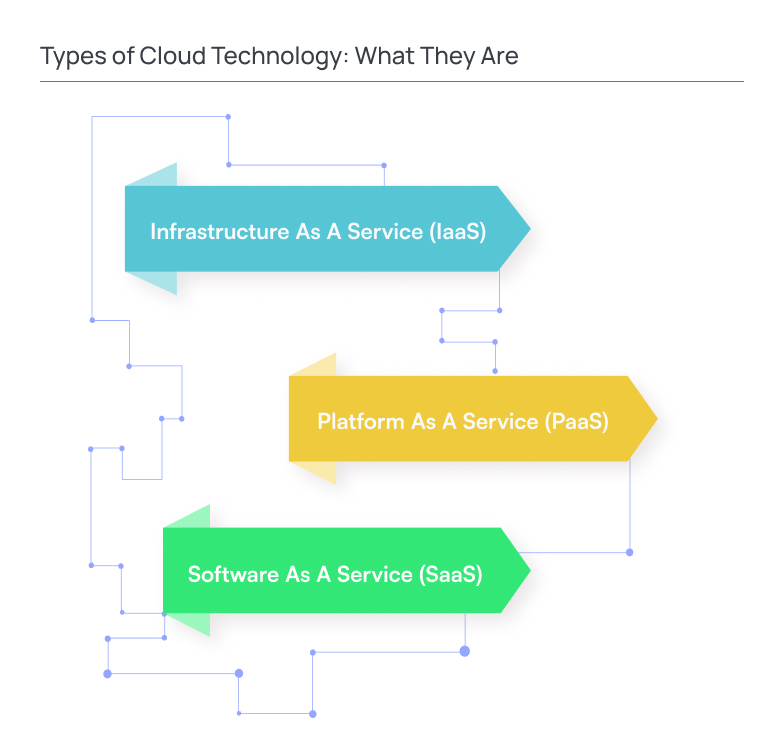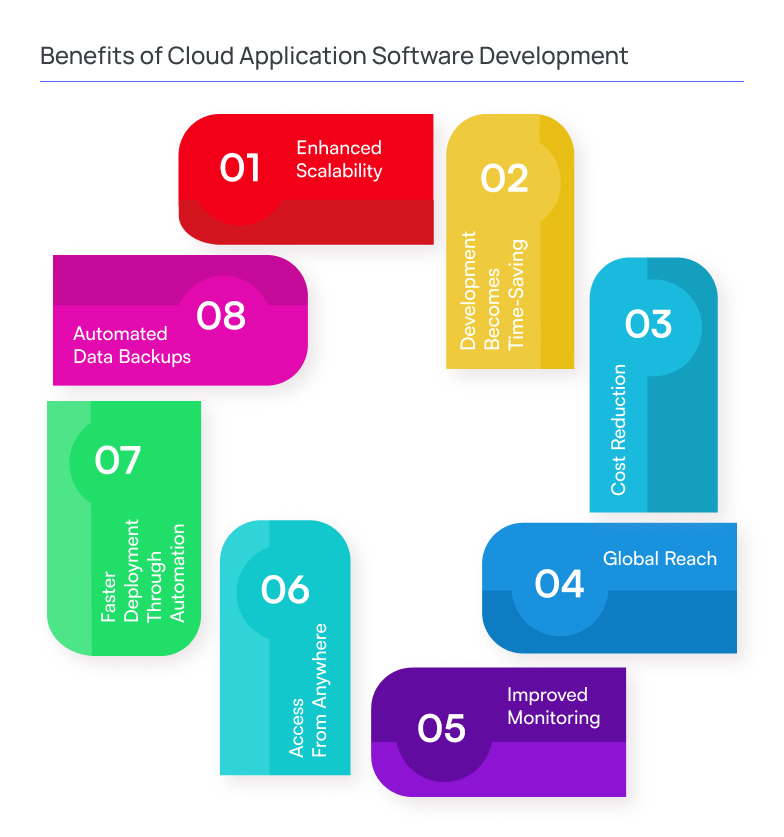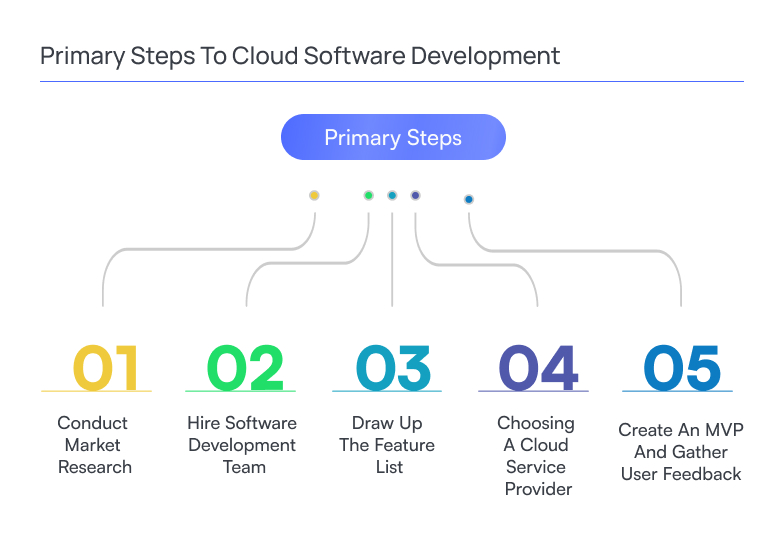The software development process is evolving, with technologies continually advancing and reshaping how developers work. Among these transformative innovations, cloud computing has become a far-reaching game-changer.
In this article, we want to delve deeply into cloud software development, explaining its types, benefits, and challenges and focusing on the main development steps. Our goal is to single out all the pros and cons of this technology to give you a better understanding of when you need it.
Thus, let’s move together and read the article to see what software development in cloud means. And don’t forget – Binerals is always here to answer all your questions, so don’t hesitate to ask!
What Is Cloud Software Development?
Cloud development, or cloud-based development, is the process of creating, testing, deploying, and running software services in a cloud environment. These applications are known as cloud software.
Cloud technology is becoming more and more popular.
The global cloud computing market is projected to reach $519 billion by 2027 (PR Newswire). Leading cloud service providers like Amazon Web Services (AWS), Microsoft Azure, and Google Cloud Platform allow businesses to embrace public, private, hybrid, and community cloud computing initiatives.
This adoption of cloud services has led to various approaches in cloud development tailored to business needs. The core concept is to use cloud resources rather than physical on-premises hardware and servers.
Businesses can seamlessly integrate cutting-edge cloud technologies into web applications and other cloud-based solutions using cloud services, including remote data centers, development tools, and operating systems. It can be achieved through cloud service models such as Platform as a Service (PaaS), Software as a Service (SaaS), and Infrastructure as a Service (IaaS).
Also, the three frequently used and sometimes interchangeable terms in cloud software development are:
Cloud-native Development
Cloud-native applications are designed to run smoothly on the cloud. Developers build them from scratch with cloud-based technologies or extensively adapt existing code. This approach enables efficient delivery of new software services through continuous integration, containers, and microservices. It means breaking down software into smaller, more flexible parts, ensuring accessibility, scalability, and adaptability in the cloud environment.
Cloud-enabled Development
Cloud-enabled development involves moving traditional software to the cloud platform. These applications are built initially on on-site hardware and resources in a unified manner.
However, cloud-enabled apps may only partially harness the maximum scalability and resource-sharing potential achievable with cloud-native applications. This limitation arises because legacy code is adjusted to function with virtual cloud resources while the fundamental architecture remains unchanged.
Cloud-based Software Development
Cloud-based development strikes a balance between cloud-native and cloud-enabled approaches. It harnesses the availability and scalability of cloud services without requiring a complete application redesign.
Thus, businesses can enjoy the benefits of the cloud for specific services without requiring extensive changes to their application code. For instance, moving a web app to an Amazon web server transforms it into a cloud-based application.
The essential advantage is that cloud-based applications relieve developers and IT teams from maintaining resources like servers, software programs, and backup schedules.
Cloud service providers are responsible for hosting and managing applications, hardware, and data in the cloud platform. Businesses pay only for the resources they use and can quickly scale up or down based on their needs.
In fact, not only industry giants can gain the lead regarding the versatility of cloud software development. Even niche markets like dating site developers can use all the benefits of the cloud. With the ability to scale, optimize, and secure their platforms, dating businesses can enhance user experiences and cover a greater audience.
Ready to move your app to the cloud? Let Binerals help you migrate your data for improved efficiency and cost savings.
Contact us!Types of Cloud Technology: What They Are
Now, let’s focus more deeply on the abovementioned cloud services models and explain more about them.

Infrastructure as a Service (IaaS)
IaaS provides maximum freedom and control for software developers. It typically involves running virtual machines using hypervisor software, encompassing computing power, data storage, networking, load balancers, and other physical and virtual resources. An alternative to hypervisors is a Linux system kernel with isolated containers.
IaaS offers a digital place where specialists can install necessary operating systems and application software. In this model, users are responsible for maintaining applications and operating systems, including installing patches and updates. Pricing is based on the resources rented from data centers and the actual resource consumption during the billing period.
Platform as a Service (PaaS)
PaaS offers a pre-configured environment for installing and running applications. This environment typically includes an operating system, a language-specific setup, a database with management tools, and a web server.
In the PaaS model, many aspects are managed by the provider, meaning clients have less control than IaaS. However, this simplifies things for software developers. They can focus on their tasks without dealing with complex infrastructure and maintenance.
Software as a Service (SaaS)
This cloud-based software development model allows users to access and use software hosted on a cloud provided by a service provider. It operates on a subscription basis, giving temporary licenses for web-hosted software. Some SaaS models offer essential functions for free, with advanced features requiring payment. Users access the software through a web browser.
SaaS provides various specialized software, often benefiting software development companies. It includes enterprise management systems for tasks like enterprise resource planning systems (ERPs), human resources management systems (HRMs), content management, etc. It also covers office suites, messengers, design software, database management systems, project management tools, and more.
Businesses have the opportunity to build cross-platform mobile apps that can run seamlessly across various devices and operating systems. This flexibility is made possible due to cloud models, which offer the tools and resources necessary to develop, test, and deploy applications.
Cloud Development vs Traditional Software Development
Traditional computing relies on centralized hardware, software, and related services. Businesses invest heavily in infrastructure and personnel for management and maintenance, which can be costly. Unlike cloud computing, it lacks the same remote access and scalability benefits. So, how is cloud development different from traditional software development?
Cloud development has gained great popularity thanks to its distinct advantages over traditional software development. Unlike the traditional model, cloud computing allows businesses to access software, hardware, and services remotely while adjusting their usage.
Companies pay only for the required services, significantly reducing initial and ongoing costs. Furthermore, cloud computing offers enhanced security and reliability through remote data access and robust encryption and security measures employed by cloud service providers.
As a result, a cloud-based software development environment provides cost savings, scalability, and convenient data access from anywhere. On the other hand, traditional development demands the purchase and management of hardware, software, and related services, which can be expensive and inflexible. As such, cloud computing is often the preferred option for businesses aiming to reduce initial costs and leverage the cloud’s scalability.
Benefits of Cloud Application Software Development
We think it would be better to detail all the benefits and challenges. Benefits come first.

Enhanced Scalability
One of the significant benefits of cloud application development is the remarkable scalability it provides. In the cloud, businesses can effortlessly expand their processing power and server storage to accommodate increasing demands without inconveniencing users. With cloud application development, as your business grows, you can seamlessly augment resources in your cloud solution, free from concerns about downtime or performance issues.
Development Becomes Time-Saving
The speed of delivering an application is a critical element in development. A slowdown in the development process can result in elevated expenses and potentially impact both the business and the future potential of the application. While cloud application development might initially demand time, it eventually conserves numerous work hours by optimizing operations and enhancing processes.
Cost Reduction
Due to reduced hardware and maintenance requirements, cloud-based applications are more cost-effective than their on-premise counterparts. In the case of IaaS, operating in a virtual environment entails fewer on-site equipment needs while offering the benefits of remote monitoring and management. Similarly, for PaaS, resources can be consolidated in a single location. Moreover, the absence of upfront expenses and an available pay-as-you-go model means you pay only for the time and resources you actually use.
Global Reach
In contrast to depending on a single geographic location for hosting, the cloud allows you to distribute your cloud application across servers worldwide. It facilitates the use of Content Delivery Networks (CDNs) to enhance the performance of your cloud application. As a result, you can expedite global application delivery, leading to improved user experiences marked by faster response times and quicker loading.
Improved Monitoring
Maintaining a new cloud application means you need to conduct monitoring to address any vital performance or security concerns swiftly. Cloud application development provides you and your team with tools for tracking and monitoring application performance. These tools grant complete control over the application, enabling prompt responses to errors and glitches.
Access From Anywhere
The cloud, being an internet-based service, offers developers the flexibility to utilize it from any location. If they have a computer with the essential requirements and Internet access, team members can access the cloud and start working, regardless of their physical location.
Faster Deployment Through Automation
Cloud software development enables businesses to introduce new features and applications using automated processes rapidly. It eliminates the necessity for manual setup or deployment, reducing the time it takes to market new products or services.
Automated Data Backups
Cloud service providers typically conduct regular backups of all stored data in the cloud. It relieves your team from performing and controlling backups, enhancing data redundancy, and offering a more focused and calm working process.
Challenges of Cloud Software Development
Even if cloud computing in software development prevails over traditional software development, there are still a few challenges you should know about.
Consider Compatibility
Not all tasks can smoothly move to the cloud, mainly if they use old systems, have slow internet, need much computing power, or don’t match well with cloud technology. Plus, cloud software should fit a company’s rules and needs.
Security Concerns
Storing data on the cloud means all your information is in one place, like putting everything in one basket. A well-protected private cloud is a great storage option, but the consequences can be severe if breached. With more and more of these breaches happening, many IT experts are worried about cloud computing.
Dependency on Service Providers
Using cloud services requires both an internet provider and a cloud provider. If either of them has issues or goes offline, users can’t access their cloud data. It can disrupt team workflows and even entire companies. This risk is one of the main downsides of cloud computing.
Primary Steps To Cloud Software Development
Any software development process requires thorough planning and following the proper steps. We will include the main steps to create your cloud app.

Conduct Market Research
The initial phase in any process involves delving into the existing industry. In this context, it requires understanding the dynamics of the market and the specific niche you intend to enter. You should analyze your competitors, get acquainted with existing trends, understand your target audience, and define a unique value proposition. The latter means that your app must be unique and provide something new to users.
Hire Software Development Team
Suppose you are not a developer and not a tech-savvy person. In that case, you’ll need a dedicated team of developers who can assist you, especially with the technical aspects of your project. Furthermore, when it comes to startup development, you will require not only programmers but also business analysts and experts in product development. That is what you can find at Binerals.
Apart from that, If you hire software developers in Ukraine, you can get many benefits. Outsourcing software development is more advantageous than hiring an in-house development team. A development team should focus on the product as a whole, not just the programming aspect. And team members should know various cloud providers and understand their pros and cons.
Thus, you must look through a website like Clutch.co, where you can find honest reviews about various companies and see their rating. And, of course, don’t forget to visit the company’s website, read their blog, and learn more about their expertise.
Draw Up The Feature List
Now, it’s time to list the essential features of your cloud app, and it will be the basis for your MVP. However, it may be challenging for you to know all the features, especially if you haven’t ordered software development previously. Here, a software development company will come to the rescue. Binerals has vast experience in various development sectors, so our specialists will help you single out the basic features required for your MVP.
Choosing a Cloud Service Provider
Specialists will decide what cloud provider fits your project better. Some prominent cloud service providers in 2023 include Amazon Web Services (AWS), Microsoft Azure, Google Cloud Platform (GCP), DigitalOcean, and Salesforce. Every cloud provider has exciting services and features to enhance your cloud app. Binerals also actively uses almost all of them for cloud software development so we will choose the most suitable one.
Create an MVP and Gather User Feedback
When developers have created the MVP of your cloud app, you need to figure out the opinion of the first users. You can even find a group of first beta users who will test an app and report about its strong and weak sides. If users don’t like something, we can update your app according to user feedback and improve it to ensure it meets their needs. That is why MVP should come first. It won’t overload the app with unnecessary features, you won’t lose thousands of dollars, and it will be a more flexible option to hit the market faster.
Conclusion
You have become acquainted with the world of cloud software development. We’ve explored the various types of cloud technology, described the advantages and challenges, and found out what development steps you should undertake.
Cloud development offers flexibility, cost savings, and enhanced scalability. It can save time, improve monitoring, and provide global reach. However, its challenges include compatibility issues, security concerns, and dependency on service providers.
Now, when you better understand cloud software development, you can make informed decisions about when and how to use this technology to your advantage. The only thing left is finding a reliable software development partner to help you. And Binerals is right here for you.
Have questions or need assistance with your cloud software development? Our experts are here to assist you. Contact Binerals for custom solutions.
Contact BineralsFAQ
What is cloud software development?
Cloud software development is the process of creating, testing, deploying, and running software services in a cloud environment. These applications are known as cloud software and rely on cloud technologies and resources instead of traditional on-premises hardware.
What are the core types of cloud technology?
There are three main cloud technology models:
- Infrastructure as a Service (IaaS): This model offers software developers the utmost freedom and control. It usually involves using virtual machines and managing resources like computing power, data storage, and networking.
- Platform as a Service (PaaS): PaaS provides a pre-configured environment for installing and operating applications. This environment typically includes an operating system, language-specific configurations, a database with management tools, and a web server. The service provider manages many aspects of this setup, simplifying the tasks for software developers.
- Software as a Service (SaaS): SaaS enables users to access and utilize software hosted in the cloud by a service provider. It functions on a subscription basis, providing temporary licenses for web-hosted software. Some SaaS models offer basic functions for free, while advanced features may require payment. Users interact with the software through a web browser.
What are the key benefits of cloud application software development?
Cloud software development offers several advantages: enhanced scalability, time efficiency, reduced costs, global reach, improved monitoring, access from anywhere, faster deployment with automated processes, and data backups.
What are the cloud software development steps?
The main steps to build good cloud software include market research, hiring a reliable software development team, drawing up a list of features and requirements, choosing cloud service providers, MVP development, beta testing, and user feedback gathering.
